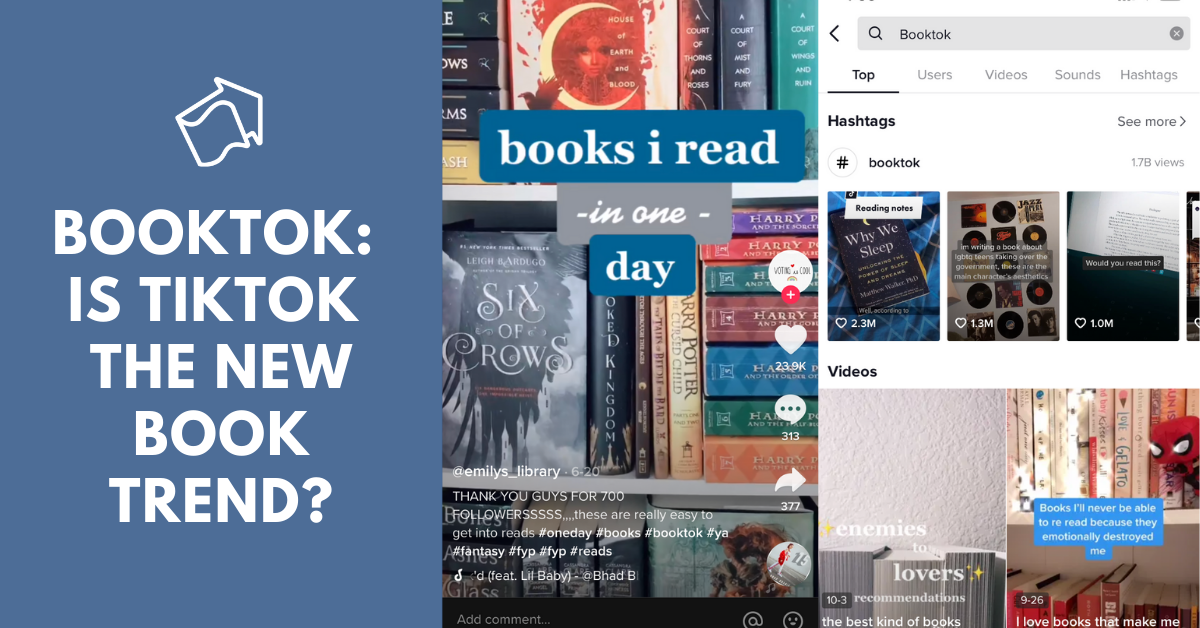You’ve seen it in the headlines, heard about it incessantly from your teenage niece, or (perhaps) you’ve even downloaded it yourself. Let’s talk about TikTok.
TikTok is a very popular app that promotes the creation of short-form video content and slideshows of no more than 1 minute in length. The app is designed so that videos have a much greater chance of going viral than, say, content on Instagram or even YouTube.
As of the time of writing this blog, TikTok has approximately 800 million monthly users, ranking just behind Instagram (1 billion monthly users). However the app is only two years old, so its growth rate is substantial. It also received a huge download boost during March-July 2020 due to Covid-19 lockdown. 50% of users in the US are under the age of 35, with the majority of users being 16-24.
Like Bookstagram, TikTok has a healthy book community. YA is the most popular genre on TikTok due to its demographic, with YA Fantasy and YA Romance/Rom-Com being among the top most popular subgenres
Just like Bookstagrammers, BookTokers are influencers who review books, offer recommendations, and flex the extensiveness of their shelves (such as @zacharyjamesoffical, @treofpaperbacks, and @amysbooknook. Authors are beginning to find very influential platforms on TikTok as well, and since the app is still relatively new, it’s not inundated/saturated with authors just yet. TikTok viewers (who are often young, aspirational writers themselves), love connecting with authors writing in their favorite genres, or engage with videos of fellow writers explaining their successes, tips, and struggles.
There is a niche on TikTok for EVERYTHING. So what makes a video become popular or go viral? Here’s the thing: Nobody knows. TikTok’s algorithm is notoriously “uncrackable” (as far as users are concerned, at least) meaning that even frequent users don’t really know why some content becomes popular and others, well, doesn’t. The pro is that technically anything can go viral; the con is that “trying to go viral” is a mystifying and frustrating endeavor. But there are a few indicators of success.
When you publish a TikTok video, the video will not be visible to 800 million users — instead, it will be introduced to a pool of a few dozen (based on what content those users have engaged with previously). If your video is watched from start to finish, liked, and shared by that small pool of users, TikTok will then “show” it to a pool of a few hundred, and then if engagement is still high, they’ll “show” it to a few thousand, and so on and so on.
Videos with high engagement get exposed to more viewers. Engagement is measured by likes, shares, comments, duets, and view time (watching the video from start to finish is best). Videos tend to get highest viewership (aka most exposure to viewers/higher engagement) within the first three hours of posting, but not always — every person who engages with your video can give it a little “boost” in the algorithm (meaning suddenly more people see it), so videos can go viral “later,” like 3-5 days after posting. This is the exception though, not the norm.
Again: No one knows the exact formula for making something go viral. Success can feel very arbitrary. However, popular TikTok content is pretty much always entertaining, authentic, and relatable. Seriously, leave your sales pitches at the door — no one is interested. But if you entertain, are authentic, or are relatable (or best, a combination of all three), the influence/following you’ll gain is extensive and unlimited. Telling people to “buy my book!” on TikTok is content-death — but authentically demonstrating your passion for your work and then asking people to check out your book / showing why it’s appealing can have a huge effect. Viewers on TikTok want to support creators; demonstrate why they should support you.

Chelsea is a copywriter, editor, publicist, and content creator at Books Forward, an author publicity and book marketing firm committed to promoting voices from a diverse variety of communities. From book reviews and author events, to social media and digital marketing, we help authors find success and connect with readers. Interested in what’s possible for your book sales and building readership? Check out our services, tell us your goals, and get a customized publicity campaign tailored just for you.


